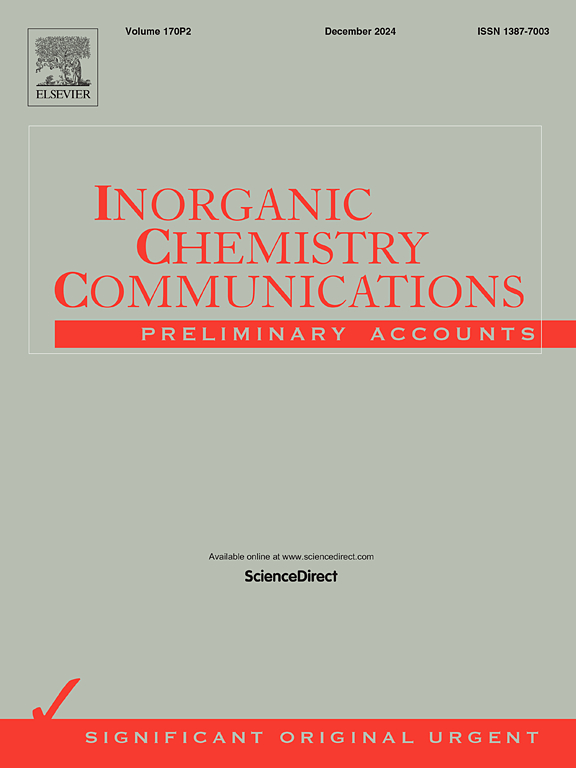2D/3D ZnS/SnO2 photocatalyst with Z-scheme heterojunction for efficient degradation of organic pollutants
IF 4.4
3区 化学
Q1 CHEMISTRY, INORGANIC & NUCLEAR
引用次数: 0
Abstract
A series of 2D/3D ZnS/SnO2-T (T = 400 °C, 500 °C, 600 °C, 700 °C) samples were synthesized, which were further applied as photocatalysts to degrade the organic pollutants. The crystal structures, particle morphologies, interfacial and photoelectric properties of the ZnS/SnO2 semiconductor photocatalysts were characterized by XRD, SEM, FT-IR, XPS, UV–Vis, CV and electrochemical impedance spectra (EIS). The catalytic performance of the ZnS/SnO2 photocatalysts was performed using methylene blue (MB) and rhodamine B (RhB) as the target pollutants, of which the ZnS/SnO2-500 exhibited the highest photocatalytic degradation performance, capable of degrading 95.02 % of MB and 59.80 % of RhB, respectively. The degradation of MB was consistent with first-order kinetics, with a degradation rate constant of 0.587 h−1 under optimal conditions (20 mg/L of MB, pH = 5, 40 mg of catalyst, 30 °C). This was attributed to the higher photoresponsive ability and lower electrochemical impedance as well as the enhanced visible light absorption capability of ZnS/SnO2-500 sample. Importantly, the ZnS/SnO2-500 photocatalyst can also be used to degrade various colorless pollutants including indole, tetracycline, norfloxacin, and ciprofloxacin, with degradation efficiencies of 46.65 %, 75.23 %, 53.98 %, and 59.19 %, respectively. Moreover, the presence of oxygen vacancies in the ZnS/SnO2 solid was confirmed according to the results of XPS and ESR analyses, which played a key role in the photocatalytic process and promoted the generation of superoxide radicals and hydroxyl radicals. Finally, the high separation and distribution of electron-hole pairs of DFT calculations suggested that the electron was transmitted from SnO2 to ZnS via the newly-formed Sn-S-Zn bond between the interfacial structures, further confirmed the proposed Z-scheme mechanism.

具有z -图式异质结的2D/3D ZnS/SnO2光催化剂用于有机污染物的高效降解
合成了一系列二维/三维 ZnS/SnO2-T (T = 400 °C、500 °C、600 °C、700 °C)样品,并将其进一步用作光催化剂来降解有机污染物。通过 XRD、SEM、FT-IR、XPS、UV-Vis、CV 和电化学阻抗谱(EIS)对 ZnS/SnO2 半导体光催化剂的晶体结构、颗粒形貌、界面和光电特性进行了表征。以亚甲基蓝(MB)和罗丹明 B(RhB)为目标污染物,对 ZnS/SnO2 光催化剂的催化性能进行了测试,其中 ZnS/SnO2-500 的光催化降解性能最高,可分别降解 95.02% 的 MB 和 59.80% 的 RhB。甲基溴的降解符合一阶动力学,在最佳条件下(20 毫克/升甲基溴、pH = 5、40 毫克催化剂、30 °C),降解速率常数为 0.587 h-1。这归因于 ZnS/SnO2-500 样品具有更高的光反射能力、更低的电化学阻抗以及更强的可见光吸收能力。重要的是,ZnS/SnO2-500 光催化剂还可用于降解各种无色污染物,包括吲哚、四环素、诺氟沙星和环丙沙星,降解效率分别为 46.65 %、75.23 %、53.98 % 和 59.19 %。此外,XPS 和 ESR 分析结果证实,ZnS/SnO2 固体中存在氧空位,在光催化过程中发挥了关键作用,促进了超氧自由基和羟自由基的生成。最后,DFT 计算得出的电子-空穴对的高度分离和分布表明,电子是通过界面结构之间新形成的 Sn-S-Zn 键从 SnO2 传输到 ZnS 的,这进一步证实了所提出的 Z 模式机理。
本文章由计算机程序翻译,如有差异,请以英文原文为准。
求助全文
约1分钟内获得全文
求助全文
来源期刊

Inorganic Chemistry Communications
化学-无机化学与核化学
CiteScore
5.50
自引率
7.90%
发文量
1013
审稿时长
53 days
期刊介绍:
Launched in January 1998, Inorganic Chemistry Communications is an international journal dedicated to the rapid publication of short communications in the major areas of inorganic, organometallic and supramolecular chemistry. Topics include synthetic and reaction chemistry, kinetics and mechanisms of reactions, bioinorganic chemistry, photochemistry and the use of metal and organometallic compounds in stoichiometric and catalytic synthesis or organic compounds.
 求助内容:
求助内容: 应助结果提醒方式:
应助结果提醒方式:


